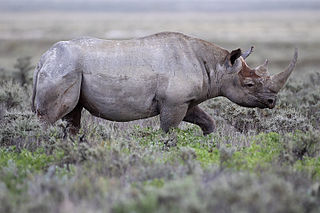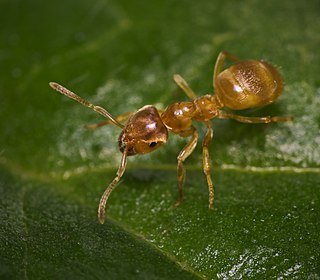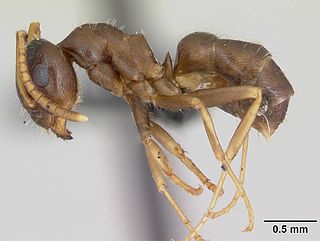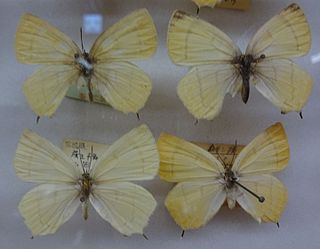
Lasius is a genus of formicine ants. The type species for this genus is the black garden ant, Lasius niger. Other major members, which live in drier heathland, are the cornfield ant, L. neoniger, and L. alienus. Other species include the temporary social parasites of the L. mixtus group and the hyper-social parasite Lasius fuliginosus. Lasius flavus is also a commonly seen species, building grassy hillocks in undisturbed pasture. In the Alps, these mounds – always aligned east to catch the first rays of the rising sun – have been traditionally used by goatherds as natural compasses. Species in the subgenus Acanthomyops, in particular L. interjectus and L. claviger, are commonly known as citronella ants due to their citronella-like smell.

The black rhinoceros, black rhino or hook-lipped rhinoceros is a species of rhinoceros, native to eastern and southern Africa including Angola, Botswana, Kenya, Malawi, Mozambique, Namibia, South Africa, Eswatini, Tanzania, Zambia, and Zimbabwe. Although the species is referred to as black, its colours vary from brown to grey. It is the only extant species of the genus Diceros.

The black garden ant, also known as the common black ant, is a formicine ant, the type species of the subgenus Lasius, which is found across Europe and in some parts of North America, South America, Asia and Australasia. The European species was split into two species; L. niger, which are found in open areas; and L. platythorax, which is found in forest habitats. It is monogynous, meaning colonies contain a single queen.

The water caltrop is any of three extant species of the genus Trapa: Trapa natans, Trapa bicornis and the endangered Trapa rossica. It is also known as buffalo nut, bat nut, devil pod, ling nut, mustache nut, singhara nut or water chestnut.

The great hornbill, also known as the concave-casqued hornbill, great Indian hornbill or great pied hornbill, is one of the larger members of the hornbill family. It occurs in the Indian subcontinent and Southeast Asia. It is predominantly frugivorous, but also preys on small mammals, reptiles and birds. It has been listed as Vulnerable on the IUCN Red List since 2018. It is known to have lived for nearly 50 years in captivity. Due to its large size and colour, it is important in many tribal cultures and rituals. The Government of Kerala declared it as the official Kerala state bird.

The yellow meadow ant, also known as the yellow hill ant, is a species of ant occurring in Europe, Asia, and North Africa. Populations in North America are now considered a different, related species, Lasius brevicornis.

The eastern black rhinoceros, also known as the East African black rhinoceros, is a subspecies of the black rhinoceros. Its numbers are very low due to poaching for its horn, and it is listed as critically endangered.

The western black rhinoceros or West African black rhinoceros is an extinct subspecies of the black rhinoceros. It was declared extinct by the IUCN in 2011. The western black rhinoceros was believed to have been genetically different from other rhino subspecies. It was once widespread in the savanna of sub-Saharan Africa, but its numbers declined due to poaching. The western black rhinoceros resided primarily in Cameroon, but surveys since 2006 have failed to locate any individuals.

Lasius neglectus is a polygynous, sometimes invasive, ant of the genus Lasius. The ant was identified in 1990 after establishing a colony in Budapest, Hungary. Superficially, they are similar in appearance to the common black garden ant, Lasius niger, but have significantly different behavioural patterns, particularly in the social structure within colonies.

Lasius alienus, or cornfield ant, is a species of ant in the subfamily Formicinae. Workers have a length of about 2–4 mm, Queens are larger (7–9 mm).

Lasius fuliginosus, also known as the jet ant or jet black ant, is a species of ant in the subfamily Formicinae.

Shirozua jonasi, the orange hairstreak, is a butterfly of the subfamily Lycaeninae. It was described by Edward Wesley Janson in 1877. It is found in the Russian Far East, north-eastern China, Korea and Japan. It is widely distributed in the forest belt.

Lasius claviger, or the smaller yellow ant, is a species of ant belonging to the genus Lasius, formerly a part of the genus Acanthomyops. Described in 1862 by Roger, the species is native to the United States.

Lasius neoniger, also known as the turfgrass ant, Labour day ant, cornfield ant or nuisance ant, is a species of ant in the genus Lasius. Found in North America, the species is common in the eastern United States and Canada, though they can be found all over the continent. They are usually light brown in color, with a slightly darker head.

Lasius brunneus is a species of ant in the genus Lasius. The species is widely distributed in Europe, from Sweden in the north to Anatolia in the south. In England this species is almost always found nesting in oak trees or rotting wood mainly foraging in trees but has also been found under stones and foraging on the ground. It is thought to be underrecorded but is fairly common especially in the South East.














